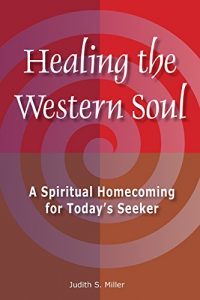 Healing the Western Soul: A Spiritual Homecoming for Today’s Seeker by Judith S. Miller
Healing the Western Soul: A Spiritual Homecoming for Today’s Seeker by Judith S. Miller
Reviewed by David Lorimer
Some readers will recall the observation by CG Jung in his Modern Man in Search of a Soul to the effect that the fundamental challenge for his patients in the second half of life was the development of a spiritual outlook. Although Jung wrote about the I Ching and The Secret of the Golden Flower as well as researching yoga and Indian philosophy, he felt that Westerners should look for spiritual resources within their own tradition, advice which he himself applied in his studies of alchemy and Gnosticism. In this important book about spiritual homecoming for today’s seeker, Judith Miller explores the modern search for meaning in a society that has lost its traditional anchors and where many are embracing Eastern paths, especially Buddhism. She shows that the collective unconscious as revealed in her patients’ dreams throws up traditional Western images and archetypes.
The three parts explore our Western spiritual angst, spiritual roots and spiritual path, drawing on Evelyn Underhill’s classic book, Mysticism, first published in 1911. The attitude of being spiritual but not religious leaves the seeker unmoored and exposed to elements of the shadow that come up along with the advent of light. Spiritual and psychological unfolding are closely related in this respect so that therapists and mentors are there to support a process; and it is crucial that they understand what is going on in spiritual terms. Miller shows how our prevalent world views of conservative pre-modern, scientific modern and relativistic postmodern are all poor guides to understanding spiritual unfoldment and, more critically, spiritual emergency. She recounts asking a question of Dr S at a conference and being denounced by him with the words never to engage in any conversation with patients about things that are not real – at which point he stormed off the stage. Diagnosing spiritual emergence as a chemical imbalance in the brain or as psychopathology can be enormously damaging. Miller illustrates this with stories of a boy being sectioned for his visions and a woman being given medication after she saw light around her dying husband. This kind of psycho-spiritual illiteracy is predictable within these world views but reveals a huge shortcoming in our medical and psychological education.
Miller is also familiar with the work of Stan Grof as another pioneer at the psycho-spiritual interface. She is rightly critical of New Age failures to engage with the shadow and shows how her clients do not always understand the significance of their own experiences. She illustrates some points from her own experience, for instance a rather extraordinary balloon synchronicity with a friend – where the inner and outer worlds meet. The second part looks at our experiences of God as the Self, Oneness and the Other as Thou. This leads into an exploration of our mystical ground, including the sacred marriage. In our quest for spiritual identity, ‘when you live out of your authentic self, you contact the extreme point where your human nature touches the Absolute.’ It is crucial, in Miller’s view – and this also echoes Albert Schweitzer – to remember that the Western path is active and choice-based, and seeks to integrate and transcend duality through a process of purification based on intent and deep commitment to the process.
Miller compresses Underhill’s five stages into three – awakening, illumination and union. She explains and illustrates the challenges of each stage, for instance the death of the ego and the dark night of the soul. We discover who we are at a deeper level and are able to connect to our inner strength so as to access healing and transformation. We come to realise, as Chief Black Elk puts it, that at the centre of the Universe dwells the Great Spirit, and that this centre is really everywhere, it is within each of us.’ This is what Ravi Ravindra calls the first person universal. The summary message of the book could not be more important in terms of a new psycho-spiritual world view. The material and spiritual will both be acknowledged, it will be understood that the soul needs healing and that breakdowns and breakthroughs are part of the process. Experiences of expanded consciousness will be trusted and validated. The adoption of this outlook will represent a huge step forward for psychospiritual health and this book makes a significant staging post and should as such be compulsory reading for traditionally trained mental health professionals.
